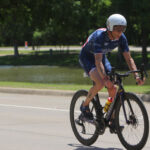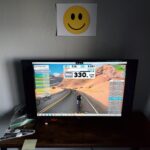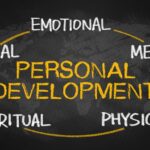If you do anything to work on the mental side of your sport, it better be mental imagery. Why, you ask. Because there is no more powerful mental tool than mental imagery and it can have a huge impact on your sports performance.
I say this with such conviction because it had that effect on me when I was a young athlete at Burke Mtn. Academy, a private boarding school in Vermont devoted to developing world-class ski racers (it was also the first full-time sports academy in the U.S.) One summer I took a course at a local college that introduced me to the power of mental imagery. I applied it to my sport as part of my final project for the class and then continued to use it throughout the following fall and into the competitive race season. The results were nothing less than spectacular. From doubt came confidence. From distraction came focus. From anxiety came intensity. From timidness came aggressiveness. From inconsistency came consistency. And, most importantly, from decent results came outstanding results.
When I studied mental imagery in graduate school, I learned why it is so powerful. Imagery is used by virtually all great athletes and research has shown that, when combined with actual practice, improves performance more than practice alone. Imagery also isn’t just a mental experience that occurs in your head, but rather impacts you in every way: psychologically, emotionally, physically, technically, and tactically. Think of mental imagery as weight lifting for the mind.
In my more than 25 years of work with professional, Olympic, collegiate, and junior-elite athletes, mental imagery is the tool that I emphasize the most with them and the one that I have seen have the greatest impact on their performances. Here’s the bottom line. If you aren’t engaged in a consistent mental imagery program, you’re not doing everything you can to achieve your athletic goals.
Keys to Quality Mental Imagery
There are four factors that impact the quality of mental imagery: perspective, control, multiple sense, and speed. You can develop each of these areas so you can get the most out of your imagery.
Imagery perspective. Imagery perspective refers to where the “imagery camera” is when you do imagery. The internal perspective involves seeing yourself from inside your body looking out, as if you were actually performing your sport. The external perspective involves seeing yourself from outside your body like on video. Research indicates that one perspective is not better than the other. Most people have a dominant perspective with which they’re most comfortable. Use the perspective that’s most natural for you and then experiment with the other perspective to see if it helps you in a different way.
Control. Have you ever been doing imagery and you keep making mistakes, for example, a basketball point guard sees the ball stick to the court while dribbling or a golfer sees her ball pop out of the cup? This problem relates to imagery control, which is how well you’re able to imagine what you want to imagine. It’s not uncommon for athletes to perform poorly in their imagery and it often reflects a fundamental lack of confidence in their ability to perform successfully (when I started using imagery as a youth, I couldn’t go three gates in a ski race course in my head without falling!).
If mistakes occur in your imagery, you shouldn’t just let them go by. If you do, you’ll further ingrain the negative image and feeling which will hurt your performances. Instead, when you perform poorly in your imagery, immediately rewind the “imagery video” and edit the imagery video until you do it correctly.
Multiple senses. Good imagery is more than just visual, that’s why I don’t like to call it visualization. The best imagery involves the multi-sensory reproduction of the actual sport experience. You should duplicate the sights, sounds, physical sensations, thoughts, and emotions that you would experience in an actual competition. Visual imagery involves how clearly you see yourself performing. If sounds, such as the quarterback calling the play at the line of scrimmage, are important, you would want to generate them in your imagery. If you get nervous before an actual competition, you should get nervous in your imagery (and then take steps to relax).
The most powerful part of mental imagery is feeling it in your body. That’s how you really ingrain new technical and mental skills and habits. A useful way to increase the feeling in your mental imagery is to combine imagined and real sensations. Imagine yourself performing and move your body along with the imagery. You see world-class athletes doing this before competitions.
Speed. The ability to adjust the speed of your imagery will enable you to use imagery to improve different aspects of your sports performance. Slow motion is effective for focusing on technique. When you first start to work on technique in your imagery, slow the imagery video down, frame by frame if necessary, to see yourself executing the skill correctly. Then, as you see and feel yourself performing well in slow motion, increase the speed of your imagery until you can perform well at “real-time” speed.
Be Realistic in Your Imagery
Imagine realistic conditions. Imagine yourself performing under realistic conditions, in other words, always do imagery under those conditions in which you normally compete. That is, if you’re usually competing in difficult conditions (e.g., cold or hot weather, snow or rain), imagine yourself performing under those conditions. Only imagine yourself performing under ideal conditions if you typically compete in ideal conditions.
Imagine realistic performance. If you’re a young athlete, don’t imagine yourself performing like a pro or Olympian. Instead, imagine yourself performing the way you normally do, but incorporate positive changes that you are working on.
Developing An Off-sport Imagery Program
The key to getting the most out of mental imagery is consistency. You wouldn’t expect to get stronger by lifting weights once every few weeks. You wouldn’t expect to get better technically by practicing your sport once in a while. The same holds true for mental imagery. The only way to gain the benefits of mental imagery is to use it consistently in a structured way.
Set imagery goals. Set specific goals for what areas you want to work on in your imagery. Goals can be technical, tactical, mental, or over-all performance. For example, you might focus on some technical change, being more relaxed and focused, or just going for it in your sport.
Climb imagery ladder. Create a ladder of practice and competitive scenarios in which you will be performing. The ladder should start with practice in a simple setting and progress to more demanding practice situations, less important competitions, and increase through more important events up to the most important competition you’ll be in this year.
Begin your imagery on the lowest level of the imagery ladder. Stay at that rung until you reach your imagery goal. When that is achieved, stay at that step for several imagery sessions to really reinforce and ingrain the positive images, thoughts, and feelings. Then work your way up the ladder until you’re performing the way you want in your imagery at the very top of the imagery ladder.
Training- and competition-specific imagery. Select practice and competitive situations that are appropriate for your level of athletic development. In other words, if you’re a high school soccer player, don’t imagine yourself playing in a World Cup game against the world’s best soccer players. Also, choose a specific competition in a precise location under particular conditions for each imagery session, thus reaching their imagery goals in a variety of competitions, settings, and conditions.
Imagery Content. Each imagery session should be comprised of your pre-performance routine and your performance in practice or competitions. If you compete in a sport that is short in duration, such as sprinting or wrestling, you can imagine an entire performance. If you compete in a sport that is lengthy, for example, golf, tennis, or soccer, you can imagine yourself performing in four or five key parts of the competition.
Imagery sessions. Imagery sessions should be done 3-4 times per week (imagery shouldn’t be done too often because, as with any type of training, you can get burned out on it). Set aside a specific time of the day when you’ll do your imagery (just like you do for your physical training). I recommend that you set your smartphone calendar to send you a reminder. Find a quiet, comfortable place where they won’t be disturbed. Each session should last about 10 minutes.
Imagery journal. One difficulty with imagery is that, unlike physical training, the results aren’t tangible. An effective way to deal with this problem is to keep an imagery journal. These logs should record key aspects of every imagery session including the quality of the imagined performance, any thoughts and feelings that occur (positive or negative), problems that emerged, and what you need to work on for the next session. An imagery journal enables you to see progress in your imagery, thereby making it more rewarding.
The Power of Mental Imagery
So, here’s the deal. I can’t guarantee that an mental imagery program is going to result in a quantum leap in your sport like it did for me in my ski racing so many years ago. But I will say that if you commit to a mental imagery program, there’s a darned good chance that you will be much better prepared mentally than you were last year. And if you combine the imagery program with an intensive physical conditioning regimen and quality practice time, then I can say with confidence that, after a few months of committed imagery, when you head out to the field, court, course, or hill, you’ll be able to say, “I’m as prepared as I can be to perform my best and achieve my goals.”






